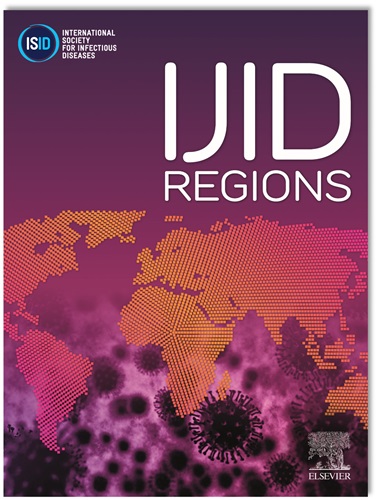评估PSS、pSOFA和SIRS对非icu环境中疑似感染儿童住院死亡率的预测准确性:一项多中心回顾性研究
IF 4.3
2区 医学
Q1 INFECTIOUS DISEASES
引用次数: 0
摘要
目的:系统比较Phoenix脓毒症评分(PSS)、小儿顺序器官衰竭评估(pSOFA)和全身性炎症反应综合征(SIRS)在评估非icu病房儿科脓毒症患者住院死亡风险中的预测准确性,为临床风险分层提供循证支持。设计:本研究采用多中心回顾性队列设计,纳入疑似感染的非icu儿科患者(不包括早产儿和出生后立即住院的新生儿),构建总队列和新生儿亚组队列。通过数据采集系统收集临床参数,并并行计算PSS、pSOFA和SIRS评分。主要终点是住院死亡率。采用R语言4.3.1版构建受试者工作特征(ROC)曲线,通过ROC曲线下面积(AUROC)评价各评分系统的区分效果。结果:2023年1月至2024年9月,共纳入13个医疗中心的965例非icu感染患儿(总队列死亡率:1.1%,11/965;新生儿亚组:193例,死亡率:4.1%,8/193)。在整个队列中,所有11名患者在病房出现病情恶化,随后根据每家医院的方案转至PICU;其中8人死于败血症,3人死于感染性休克。多因素调整后,整个队列中PSS评分的AUROC值为0.756 (99% CI: 0.731-0.780),比SIRS标准(0.730,99% CI: 0.543-0.873)提高了3.6%,但低于pSOFA评分(0.845,99% CI: 0.568-0.966)。在新生儿亚组中,PSS评分的AUROC值为0.764 (99% CI: 0.478 ~ 0.927),与SIRS标准(0.757,99% CI: 0.475 ~ 0.905)相当,但仍低于pSOFA评分(0.819,99% CI: 0.533 ~ 0.983)。三种评分系统间比较差异无统计学意义(P < 0.05)。结论:这些研究结果表明,在非icu临床情况下,与传统评估工具相比,PSS评分并没有表现出优越的预测价值。本文章由计算机程序翻译,如有差异,请以英文原文为准。
Assessing the prognostic accuracy of the PSS, pSOFA, and SIRS for in-hospital mortality in children with suspected infection in non-ICU settings: a multicenter retrospective study
Objectives
To systematically compare the predictive accuracy of the Phoenix Sepsis Score (PSS), the Pediatric Sequential Organ Failure Assessment (pSOFA), and systemic inflammatory response syndrome (SIRS) in assessing in-hospital mortality risk among pediatric sepsis patients in non-intensive care unit (non-ICU) wards, thereby providing evidence-based support for clinical risk stratification.
Design
This study employed a multicenter retrospective cohort design, enrolling non-ICU pediatric patients with suspected infections (excluding preterm infants and neonates hospitalized immediately after birth), to construct an overall cohort and a neonatology subgroup cohort. Clinical parameters were collected through a data acquisition system, with parallel calculations of PSS, pSOFA, and SIRS scores. The primary endpoint was in-hospital mortality. Receiver operating characteristic (ROC) curves were constructed via R language version 4.3.1, and the discriminatory performance of each scoring system was evaluated via the area under the ROC curve (AUROC).
Results
From January 2023 to September 2024, 965 non-ICU pediatric patients with infections were enrolled from 13 medical centers (overall cohort mortality: 1.1%, 11/965; neonatology cohort: 193 cases, mortality: 4.1%, 8/193). In the overall cohort, all 11 patients experienced deterioration on the ward and were subsequently transferred to the pediatric intensive care unit (PICU) in accordance with each hospital's protocol; eight of them died from sepsis, and three from septic shock. After multivariate adjustment, the AUROC value of the PSS score in the overall cohort was 0.756 (99% CI: 0.731-0.780), representing a 3.6% improvement over the SIRS criteria (0.730, 99% CI: 0.543-0.873) but lower than the pSOFA score (0.845, 99% CI: 0.568-0.966). In the neonatology cohort, the AUROC value of the PSS score was 0.764 (99% CI: 0.478-0.927), comparable to that of the SIRS criteria (0.757, 99% CI: 0.475-0.905) but still lower than that of the pSOFA score (0.819, 99% CI: 0.533-0.983). No statistically significant differences were observed among the three scoring systems (P > 0.01).
Conclusions
These findings suggest that the PSS score does not demonstrate superior predictive value compared with traditional assessment tools in non-ICU clinical scenarios.
求助全文
通过发布文献求助,成功后即可免费获取论文全文。
去求助
来源期刊
CiteScore
18.90
自引率
2.40%
发文量
1020
审稿时长
30 days
期刊介绍:
International Journal of Infectious Diseases (IJID)
Publisher: International Society for Infectious Diseases
Publication Frequency: Monthly
Type: Peer-reviewed, Open Access
Scope:
Publishes original clinical and laboratory-based research.
Reports clinical trials, reviews, and some case reports.
Focuses on epidemiology, clinical diagnosis, treatment, and control of infectious diseases.
Emphasizes diseases common in under-resourced countries.

 求助内容:
求助内容: 应助结果提醒方式:
应助结果提醒方式:


